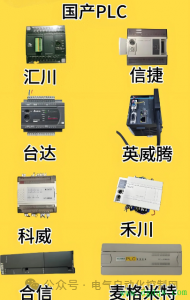When you first enter the industry, facing a dazzling array of PLC brands, do you feel as lost as a headless fly? “Which one is more stable?” “Which offers better cost performance?” “How do I choose between domestic and imported options?” These questions kept me awake at night. To find answers, I scoured materials, compared parameters, and even consulted several industry veterans. Now, after years of practical experience, I have finally clarified the pros and cons of domestic and imported PLCs, and today I will share them with you without reservation! 1. Domestic PLCs: From ‘Catch-Up’ to ‘Powerhouse’ Once upon a time, domestic PLCs were labeled as “low-end” and “unstable,” but today, they have come a long way! Core Advantages: ✅ Cost Performance King: Prices are 30%-50% lower than imports for equivalent performance; ✅ Localized Service: Technical support responds quickly and understands domestic user needs better; ✅ Accelerated Innovation: Rapid deployment in new technology fields such as IoT and AI. Recommended Star Brands: 1. Delta PLC
-
Positioning: First choice for small to medium projects
-
Highlights: Simple programming (similar to Mitsubishi FX series), strong stability, affordable pricing.
-
Applicable Scenarios: Assembly line control, packaging machinery, etc.
2. Inovance Technology PLC
-
Positioning: High-end domestic breakthrough
-
Highlights: Supports high-speed buses like EtherCAT, performance comparable to Siemens S7-1500, rapid technology iteration.
-
Applicable Scenarios: Lithium battery equipment, semiconductor manufacturing, and other high-precision fields.
3. Holley Technology/Xinjie PLC (Supplementary Recommendation)
-
Highlights: Modular design is flexible, suitable for non-standard automation projects.
-

2. Imported PLCs: Technological Accumulation, Steady as a Rock Undeniably, imported PLCs still dominate the high-end market, especially brands like Siemens, Schneider, and Rockwell. Core Advantages: ✅ Global Experience: A century of industrial automation accumulation, stability tested in extreme environments; ✅ Software Ecosystem: Such as Siemens TIA Portal, integrating programming, debugging, and simulation, with powerful functionality; ✅ Industry Benchmark: In fields like automotive and chemical industries, where reliability is crucial, imported PLCs remain the first choice. Recommended Star Brands: 1. Siemens S7 Series
-
Positioning: The “crown jewel” of industrial automation
-
Highlights: PROFINET bus, redundancy systems, safety PLCs, and other advanced technologies, suitable for large projects.
-
Applicable Scenarios: Automotive production lines, wind farm monitoring, etc.
2. Rockwell (AB) ControlLogix
-
Positioning: Expert in complex system integration
-
Highlights: Supports multiple protocols (EtherNet/IP, ControlNet, etc.), flexible programming, but high learning cost.
-
Applicable Scenarios: Large oil refineries, rail transit, etc.
3. Schneider M580 Series (Supplementary Recommendation)
-
Highlights: Built-in safety features, compliant with IEC 61508 standards, suitable for high-risk industries.
3. Selection Secrets: Customize According to Needs, Avoid Pitfalls! Key Steps: 1. Clarify Requirements
-
Small Projects (<50 points I/O): Delta, Omron offer high cost performance;
-
Large Projects (>200 points I/O): Siemens, AB are more reliable.
2. Budget and Cost Performance
-
Domestic PLCs: Brands like Delta, Xinjie have significant price advantages;
-
Imported PLCs: Siemens, Rockwell have lower long-term usage costs (due to lower failure rates).
3. Technical Support
-
Domestic PLCs: Brands like Inovance, Holley have local engineers who respond quickly;
-
Imported PLCs: Siemens, Schneider have a well-established global service network.
4. Future Expandability Prioritize PLCs that support open protocols like EtherCAT and OPC UA for easy integration with industrial internet platforms. 4. The Future of PLCs: The Wave of Intelligence and Networking Trend 1: AI Empowering PLCs Siemens has launched the “MindSphere” industrial cloud platform for real-time analysis of PLC data; Inovance Technology integrates AI algorithms to optimize predictive maintenance of equipment. Trend 2: 5G + PLC 5G networks reduce PLC communication latency, supporting remote collaborative control; Domestic PLCs (like Delta) have launched 5G communication modules to meet smart factory needs. Trend 3: Green Energy Saving Schneider has introduced the “EcoStruxure” architecture, reducing PLC energy consumption by 30%; Domestic PLCs (like Xinjie) reduce idle running of equipment through optimization algorithms. 5. Conclusion: Domestic vs. Imported, How to Choose?
-
Limited budget, simple projects: Choose domestic PLCs (like Delta, Omron);
-
Complex systems, long-term stability: Choose imported PLCs (like Siemens, Rockwell);
-
Emerging technology needs: Pay attention to domestic PLCs (like Inovance) for innovations in AI and 5G.
Future Outlook: Domestic PLCs are transitioning from “catch-up” to “leaders,” especially in the fields of intelligence and networking. As China’s manufacturing industry upgrades, the market share of domestic PLCs will undoubtedly increase further! Which PLC are you selecting for your project? Are you pursuing cost performance or stability and reliability? Feel free to share your needs in the comments section, and let’s discuss the best solutions together!